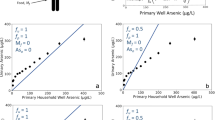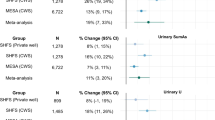Abstract
Consumption of inorganic arsenic in drinking water at high levels has been associated with chronic diseases. Research groups have estimated historic exposure using databases and models of arsenic in drinking water supplies, along with participant residential histories. Urinary arsenic species are an established biomarker of recent exposure; we compare arsenic concentrations in historically collected urine samples with predicted estimates of arsenic exposure. Using a cohort of 462 subjects with at least one urine sample collected from 1984-1992 and an arsenic exposure estimate through drinking water at the time of the urine sample, individual exposure estimates were compared with speciated urine arsenic (UAs) concentrations using correlation and multiple regression analyses. Urine inorganic arsenic (UIAs) concentrations (trivalent arsenic, pentavalent arsenic, monomethylarsonic acid, dimethylarsonic acid) were best predicted by residential water arsenic concentrations (R2=0.3688), compared with metrics including water consumption (R2=0.2038) or water concentrations at employment locations (R2=0.2331). UIAs concentrations showed similar correlation when stratified by whether the arsenic concentration was predicted or measured. Residential water arsenic concentrations, independent of water intake or water concentrations at places of employment, best explain the variability in UIAs concentrations, suggesting historical reconstruction of arsenic exposure that accounts for space-time variability and water concentrations may serve as a proxy for exposure.
This is a preview of subscription content, access via your institution
Access options
Subscribe to this journal
Receive 6 print issues and online access
$259.00 per year
only $43.17 per issue
Buy this article
- Purchase on Springer Link
- Instant access to full article PDF
Prices may be subject to local taxes which are calculated during checkout
Similar content being viewed by others
Abbreviations
- AB:
-
Arsenobetaine
- UAs:
-
Total Urine Arsenic
- As3+:
-
Trivalent Arsenic
- As5+:
-
Pentavalent Arsenic
- DM:
-
Diabetes Mellitus
- DMA:
-
Dimethylarsonic Acid
- MMA:
-
Monomethylarsonic Acid
- SLVDS:
-
San Luis Valley Diabetes Study
- SLV:
-
San Luis Valley
- UAs:
-
Urine Arsenic
References
Brown KG, Ross GL . Arsenic, drinking water and health: A position paper of the American Council of Science and Health. Regul Toxicol Pharmacol 2002; 36: 162–174.
Steinmaus C, Yuan Y, Liaw J, Smith AH . Low-level population exposure to inorganic arsenic in the United State and Diabetes Mellitus. Epidemiology 2009; 20: 807–815.
Lai MS, Hsueh YM, Chen CJ, Shyu MP, Chen SY, Kuo TL et al Ingested inorganic arsenic and prevalence of diabetes mellitus. Am J Epidemiol 1994; 139: 484–492.
Rahman M, Tondel M, Ahmad SA, Axelson O . Diabetes mellitus associated with arsenic exposure in Bangladesh. Am J Epidemiol 1998; 148: 198–203.
Tseng CH, Tai TY, Chong CK, Tseng CP, Lai MS, Lin BJ et al Long-term arsenic exposure and incidence of noninsulin-dependent diabetes mellitus: a cohort study in arseniasis-hyperendemic villages in Taiwan. Environ Health Perspect 2000a; 108: 847–851.
Wang SL, Chiou JM, Chen CJ, Tseng CH, Chou WL, Wang CC et al Prevalence of non-insulin-dependent diabetes mellitus and related vascular diseases in southwestern arseniasis-endemic and nonendemic areas in Taiwan. Environ Health Perspect 2003; 111: 155–159.
Hough RL, Fletcher T, Leonardi GS, Goessler W, Gnagnarella P, Clemens F et al Lifetime exposure to arsenic in residential drinking water in Central Europe. Int Arch Occup Environ Health 2010; 83: 471–481.
Meliker JR, Slotnick MJ, AvRuskin GA, Schottenfeld D, Jacquez GM, Wilson ML et al Lifetime exposure to arsenic in drinking water and bladder cancer: A population-based case-control study in Michigan. Cancer Causes Control 2010; 21: 745–757.
Hill A, Fanning EL, Perry K, Bowler RG, Buckell HM, Druett HA et al Studies in the incidence of cancer in a factory handling inorganic compounds of arsenic. Br J Ind Med 1951; 5: 1–2.
O’Conner JT, O’Conner TL . Arsenic in drinking water. Part I. The Development of Drinking Water Regulations. 2001. http://www.h2oc.com/pdfs/DW.pdf (accessed February 2012).
Smith AH, Lopipero PA, Bates MN, Steinmaus CM . Arsenic epidemiology and drinking water standards. Science 2002; 296: 2145–2146.
Jarup Lars . Hazards of heavy metal contamination. Br Med Bull 2003; 68: 167–182.
US Geological Survey. http://co.water.usgs.gov/trace/pubs/arsenic_fig1.html (accessed 2007).
Marchiset-Ferlay N, Savanovitch C, Sauvant-Rochat MP . What is the best biomarker to assess arsenic exposure via drinking water? Environ Int 2012; 39: 150–171.
Kurttio P, Komulainen H, Hakala E, Kajelin H, Pekkanen J . Urinary excretion of arsenic species after exposure to arsenic present in drinking water. Arch Environ Contam Toxicol 1998; 34: 297–305.
Calderon RL, Hudgens E, Le XC, Schreinemachers D, Thomas DJ . Excretion of arsenic in urine as a function of exposure to arsenic in drinking water. Environ Health Perspect 1999; 107: 663–667.
Ng JC, Wang J, Shraim A . A global health problem caused by arsenic from natural sources. Chemosphere 2003; 52: 1353*–11359.
Pellizzari ED, Clayton CA . Assessing the measurement precision of various arsenic forms and arsenic exposure in the National Human Exposure Assessment Survey (NHEXAS). Environ Health Perspect 2006; 114: 220–227.
Rivera-Núñez Z, Meliker JR, Meeker JD, Slotnick MJ, Nriagu JO . Urinary arsenic species, toenail arsenic, and estimates of arsenic intake in a Michigan population with low levels of arsenic in drinking water. J Expo Sci Environ Epidemiol 2012; 22: 182–190.
Guha Mazumder DN, Haque R, Ghosh N, De BK, Santra A, Chakraborty D et al Arsenic levels in drinking water and the prevalence of skin lesions in West Bengal, India. Int J Epidemiol 1998; 27: 871–877.
Roychowdhury T, Tokunaga H, Ando M . Survey of arsenic and other heavy metals in food composites and drinking water and estimation of dietary intake by the villagers from and arsenic-affected area of West Bengal, India. Sci Total Environ 2002; 308: 15–35.
Orloff KKMistry, Metcalf S . Biomonitoring for environmental exposures to arsenic. J Toxicol Environ Health 2009; 12: 509–524.
Gong G, O’Bryant SE . Low-level arsenic exposure, AS3MT gene polymorphism and cardiovascular diseases in rural Texas counties. Environ Res 2012; 113: 52–57.
Makris KC, Christophi CA, Paisi M, Ettinger AS . A preliminary assessment of low level arsenic exposure and diabetes mellitus in Cyprus. BMC Public Health 2012; 12: 334.
Hamman RF, Marshall JA, Baxter J, Kahn LB, Mayer EJ, Orleans M et al Methods and prevalence of non-insulin-dependent diabetes mellitus in a biethnic Colorado population. Am J Epidemiol 1989; 159: 295–311.
Concha G, Vogler G, Nermell B, Vahter M . Intra-individual variation in the metabolism of inorganic arsenic. Int Arch Environ Med 2002; 75: 576–580.
National Research Council. Arsenic in Drinking Water: 2001 Update 2001. National Academy Press: Washington, DC.
James KA . The association between lifetime exposure to arsenic in drinking water and coronary heart disease and diabetes mellitus. [dissertation]. [Aurora]: University of Colorado, Denver; 2010 Appendix A.
Steinmaus CM, Yuan Y, Smith AH . The temporal stability of arsenic concentrations in well water in western Nevada. Environ Res 2005; 99: 164–168.
Barr DB, Wilder LC, Caudill SP, Gonzalez AJ, Needham LL, Pirkle JL . Urinary creatinine concentrations in the U.S. population: implications for urinary biologic monitoring measurements. Environ Health Perspect 2005; 113: 192–200.
Lindberg AI, Goessler W, Gurzau E, Koppova K, Rudnai P, Kumar R et al Arsenic exposure in Hungary, Romania, and Slovakia. J Environ Monit 2006; 8: 203–208.
Sun G, Xu Y, Li X, Jin Y, Li B, Sun. X . Urinary arsenic metabolites in children and adults exposed to arsenic in drinking water in Inner Mongolia, China. Environ Health Perspect 2007; 115: 648–652.
Hata A, Yamanaka K, Habib MA, Endo Y, Fujitani N, Endo G . Arsenic speciation analysis of urine samples from individuals living in an arsenic-contaminated area in Bangladesh. Environ Health Perspect 2012; 17: 235–245.
Meza MM, Kopplin MJ, Burgess JL, Gandolfi AJ . Arsenic drinking water exposure and urinary excretion among adults in the Yaqui Valley, Mexico. Environ Res 2004; 96: 119–126.
Hall M, Chen Y, Ahsan H, Dlavkovich V, van Geen A, Parvez F et al Blood arsenic as a biomarker of arsenic exposure: results from a prospective study. Toxicology 2006; 225: 225–233.
Mandal BK, Orga Y, Suzuki KT . Speciation of arsenic in human nail and hair from arsenic affected area by HPLC inductively coupled argon plasma mass spectrometry. Toxicol Appl Pharmacol 2003; 189: 73–83.
Apostoli P, Bartoli D, Alessio L, Buchet JP . Biological monitoring of occupational exposure to inorganic arsenic. Occup Environ Med 1999; 56: 825–832.
Gamble MV, Liu X . Urinary creatinine and arsenic metabolism. Environ Health Perspect 2005; 113: A442.
Loffredo CA, Aposhian HV, Cebrian ME, Yamauchi H, Silbergeld EK . Variability in human metabolism of arsenic. Environ Res 2003; 92: 85–91.
Agency for Toxic Substances and Disease Registry 1990 Toxicological Profile for Arsenic (Update). PB/2000/108021.
Tao SS, Bolger PM . Dietary arsenic intakes in the United States. FDA Total Diet Study, September 1991December 1996. Food Addit Contam 1999; 16: 465–472.
Navas-Acien A, Umans JG, Howard BV, Goessler W, Francesconi KA, Crainiceanu CM et al Urine arsenic concentrations and species excretion patterns in american indian communities over a 10-year period: The Strong Heart Study. Environ Health Perspect 2009; 117: 1428–1433.
Caldwell KL, Jones RL, Verdon CP, Jarrett JM, Caudill SP, Osterloh JD . Levels of urinary total and speciated arsenic in the US population: National Health and Nutrition Examination Survey 2003–2004. J Expo Sci Environ Epi 2009; 19: 59–68.
Acknowledgements
We would like to thank Laurie-Peterson Wright and the chemistry laboratory staff at the Colorado Department of Public Health and Environment for their contribution to this research. We would also like to thank Dr. Richard Hamman for authorization to conduct this research as part of the San Luis Valley Health Studies. We would like to thank all of the participants and residents of the SLV whose courtesy and interest in the research was the source of its success. Lastly, we would like to thank the numerous people whose contribution to this study was invaluable.
Author information
Authors and Affiliations
Corresponding author
Ethics declarations
Competing interests
The authors declare no conflict of interest.
Rights and permissions
About this article
Cite this article
James, K., Meliker, J., Marshall, J. et al. Validation of estimates of past exposure to arsenic in drinking water using historical urinary arsenic concentrations. J Expo Sci Environ Epidemiol 23, 450–454 (2013). https://doi.org/10.1038/jes.2013.8
Received:
Revised:
Accepted:
Published:
Issue Date:
DOI: https://doi.org/10.1038/jes.2013.8



